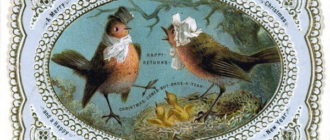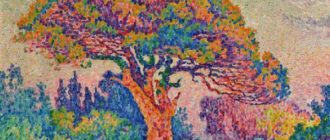
The Swing is a painting by the genius French artist Jean-Honore Fragonard, a cult work of the Rococo era. The frivolous plot reflects the mores of the secular society of France at that time. A short episode is presented – a summer evening from the life of noble persons.
In the center of the canvas is a young woman in a lush pink dress floating on a swing. They are rocked by an elderly man in the shady thickets of the garden. A young man is hiding in front of the heroine, behind a hedge of bushes. The piquancy of the moment lies not only in the fact that he contemplates the legs of the beauty, but also in the fact that the character swinging the swing does not know about the presence of an opponent. With youth, grace and charm, the heroine keeps both gentlemen near her.
The lady, with a graceful movement of her foot, throws one shoe towards the marble statue of Cupid, which personifies prudence and secrecy. With a finger to his lips, the god of love demonstrates the promotion of the obscene behavior of lovers. The swing movement is accentuated by faint shadows that draw attention to the girl’s shining eyes.
Her figure is drawn with a dry brush, and the light reflections, folds of the dress, ornaments are detailed using the impasto technique. This artistic technique allows you to make the center of the composition bright and memorable. The carefree, joyful atmosphere of the people is contrasted with a disturbing dark green background. Through the landscape, the master expressed his point of view on the event, the author’s attitude to the heroes of the work.
The painting “The Swing” by Jean-Honore Fragonard is a work that reflects the spirit of aesthetic sophistication and aristocratic decline
The painter managed to convey to the audience that the romantic situation shown in the picture in real life does not make anyone happy. The surrounding nature is presented in dark colors. The unrestrained dense greenery covering the sky and the gnarled trunk of the tree symbolize the moral sickness of society. As you contemplate the work, the feeling of soaring is gradually replaced by mental discomfort.
The title of the painting: “Swing” or “Happy Swing Opportunities” (fr. Les Hasards heureux de l’escarpolette).
Author: Jean-Honore Fragonard (1732-1806).
Year of writing: approx. 1767 g.
Size: 81 x 64.2 cm.
Rococo.
Genre: Pastoral.
Technique: Oil painting.
Material: Canvas.
Location: The Wallace Collection, London.
Jean-Honore Fragonard is the most famous representative of the gallant art of the 18th century.
Romanticized postures of people, mythological symbolism, a wealth of subtle shades are characteristic of the artist’s paintings. Its graceful color palette, playful content and unique style of painting give the paintings an amazing weightlessness.
The Swing, originally known as The Happy Swing Opportunity, was commissioned by Baron de Saint-Julien, who wanted to capture his beloved. Moreover, according to the idea of the customer, the priest should swing the swing. But the artist put a deeper meaning into the work, adding a special subtext to the plot.
The swing is a symbol of fleeting happiness that takes possession of a person for a short moment. This attribute of harmony and movement with an element of risk characterizes the unstable position of a person in the world. An exciting flight on a swing is simultaneously associated with a tragic end and with a joyful approach to the palaces of heaven. The master’s picturesque creation was hidden from human eyes for a long time.
The piece was transferred from one private collection to another. It was only in 1900 that the “fashionable” masterpiece of the past, which captures the hidden instincts of bourgeois society, became available to the general public. The painting “The Swing” by Jean-Honore Fragonard attracts the attention of the audience with its exquisite decorativeness, airiness of the pictorial manner. Artistic techniques emphasize the ephemerality of the captured moment and its drama.






